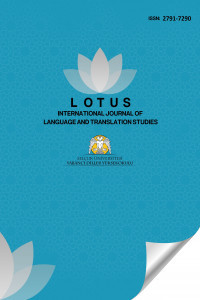The Translation Process: The Status of Tranface (the Translator’s Preface) Among Iranian Readers
The Translation Process: The Status of Tranface (the Translator’s Preface) Among Iranian Readers
Translation, Preface, Tranface Translator's Visibility,
___
- Aktener, I. (2019). A case study of translator’s preface in Yok Edici. RumeliDE Dil ve Edebiyat Araştırmaları Dergisi, (14), 439-453. doi: 10.29000/rumelide.541081
- Batchelor, K. (2018). Translation and paratexts. London: Routledge.
- Bikmanienė, M. (2019). Translator’s preface as a genre: A comparative analysis of Lithuanian and English prefaces. Sciendo: Sustainable Multilingualism, 12, 184-201.
- Buhler, H., (1979). Superasentential semantics and translation. Meta, 24(4), 451-458.
- Dimitriu, R. (2009). Translators’ prefaces as documentary sources for translation studies. Perspectives: Studies in Translatology, 17(3), 193-206.
- Genette, G. (1997). Paratexts: Thresholds of interpretation (J. E. Lewin, Trans.). Cambridge: Cambridge University Press. (Original book published 1987)
- Gomez, M. C. B. (2003). The preface as a genre in English translations in the 17th century. Estudios Humanísticos Filología, 185-196. doi:10.18002/ehf.v0i25.2697
- Haroon, H. (2017). The translator's preface as a paratextual device in Malay-English literary translations. Translation and Interpreting 9(2), 100-113.
- Hatim, B. & Munday, J. (2004). Translation: An advanced resource book. London: Routledge.
- Hlebec, B. (1989). Factors and steps in translating. Babel, 35(3), 129-141.
- Hayes, A. (2020, October 7). Chi-square (χ2) statistic definition. Investopedia. Retrieved from https://www.investopedia.com/terms/c/chi-square-statistic.asp
- McRae, E. (2010). The role of translators’ prefaces to contemporary literary translations into English (master’s thesis). Retrieved from https://www.researchspace.auckland.ac.nz/ bitstream/handle/2292/5972/whole.pdf?sequence=5
- Newmark, P. (1991). About translation multilingual matters. Clevedon: Multilingual Matters.
- Newmark, P. (1988). A textbook of translation. London: Longman.
- Pellatt, V. (Ed.). (2013). Text, extratext, metatext and paratext in translation. Newcastle: Cambridge Scholars Publishing.
- Preston, V. (2009). Questionnaire survey. International Encyclopedia of Human Geography, 46-52.
- Price, P., Jhangiani, R., & Chiang, I. (2015). Research methods of psychology (2nd Canadian ed.). Victoria, B.C.: BCcampus. Retrieved from https://opentextbc.ca/researchmethods/.
- Sheikhi, M. (2019). Iranians spend 7 hours per month reading. Mehr News Agency. Retrieved from https://en.mehrnews.com/news/141143/
- Wilss, W. (1982), The Science of Translation. Tübingen: Günter Narr.
- Başlangıç: 2021
- Yayıncı: Selçuk Üniversitesi
Kültürlerarası Teknik İletişimin Görsel Yönleri: Bilişsel Bilimsel ve Göstergesel Bakış Açısı
Çevirmen: Ayşe Melike ÖZEKMEKÇİ
Çin Düşüncesi ve Kültürü Temel Kavramları I
The Translation Process: The Status of Tranface (the Translator’s Preface) Among Iranian Readers
ÇİN KLASİK METİNLERİNDE YAKIN ANLAMLILIK SORUNU: “KIRGIZ” ADI ÖRNEĞİ
Dorian Gray’in Portresini, Immanuel Kant’ın Ahlak Felsefesiyle Yeniden Düşünmek
